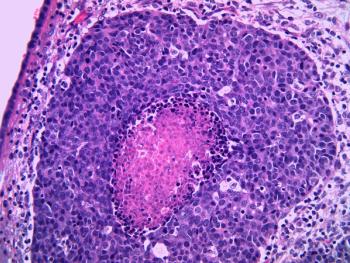
Investigative Drug Combination Kills Pancreatic Cancer Cells
Lowering antioxidant levels shows promise treating pancreatic cancer.
A novel drug therapy helps kill pancreatic cancer cells by lowering the levels of antioxidants, a study published in Cell found.
It is commonly believed that
However, proliferating cancer cells present a unique case where more oxidants are made in malignant cells with more antioxidants, which counters the impact of rising oxidation. Without commensurately more antioxidants, the malignant cells start to die off because of excessive oxidation.
“Of course, that’s exactly what we want cancer cells to do — to burn themselves out,” said Christine Chio, who led the experiments. “The therapeutic principle our lab is testing is whether, by increasing the level of oxidation in cancer cells, we can cause pre-malignant and malignant cells to die.”
When cells detect excessive oxidation, they kill themselves, according to the study, which noted that one way to increase oxidation in cancer cells is to decrease their levels of antioxidants. Researchers sought to determine the best way to do this without harming healthy cells.
The researchers focused on the protein NRF2, which referred to is as a master regulator of redox homeostasis, according to the study. When NRF2 is active, the cells synthesize glutathione, which suggests that NRF2 activity should be reduced or stopped altogether.
However, researchers said this is not possible because it is a transcription factor, which are notoriously difficult to target with drugs, and plays a role in other processes.
“You probably wouldn’t want to knock it out, in any case, because in addition to promoting production of glutathione, NRF2 has a role in regulating several hundred different genes,” Chio said.
After conducting experiments in pancreas cells grown in the lab, and testing several new therapeutic approaches in an animal model of pancreatic cancer, researchers found an entirely different strategy. While using a panel of pancreas organoids containing spherical agglomerations of pancreas cell samples from individuals with pancreatic cancer and from the healthy pancreas, researchers were able to see what happened when NRF2 was completely eliminated.
The test was run in normal, pre-malignant and malignant pancreas organoids, with the premalignant organoids carrying cellular mutations in the KRAS gene. The malignant organoids also carried the same mutation, plus a mutation that inactivated the tumor suppressor gene, p53.
The results of the study showed that when NRF2 was eliminated, the process of protein synthesis became very sensitive to fluctuations in the balance between antioxidants and oxidants; however, in normal pancreas cells researchers found that protein synthesis was not impacted.
“We were very excited when we saw this,” Chio said. “This meant that if we could find a way of reducing antioxidants, protein synthesis would only be impacted in precancerous and malignant cells, a potentially powerful therapeutic strategy.”
This phenomenon is referred to as synthetic lethality, and occurs when a condition that affects both healthy and unhealthy cells are only lethal to the unhealthy cells. During the study, researchers decided to deliver 2 drugs, an AKT inhibitor and BSO, to mouse models of pancreatic cancer.
The AKT inhibitor is designed to inhibit the beginning of the translation process that leads to protein synthesis, while BSO inhibits the synthesis of glutathione. Previously, AKT inhibitors used alone in mouse models and human patients produced only modest survival benefits.
As a result, researchers wanted to combine it with another agent as a strategy to biochemically mimic what would happen if NRF2 could be knocked out, or the levels reduced.
“We hoped that by combining them with BSO we might generate a synergy that would boost its effectiveness,” Chio said. “This is where our pancreas organoid system was so valuable. We were able to test this idea and see that this approach was synthetically lethal — it did not increase the killing power of the AKT inhibitor, but the synergy was not present in the setting of normal pancreas cells.”
The findings indicate a synergistic effect in the pancreatic cancer mouse model, and indicate that decreasing cancer cell antioxidant levels kills more cancer. However, the authors noted that they are working to optimize the treatment by combining different combinations of translation inhibitors and repressors of antioxidant synthesis.
“Pancreatic cancer employs NRF2 as one of its henchmen to promote bad behavior, but the details were previously unclear,” said lead researcher David Tuveson, MD, PhD. “By developing organoid models, Christine, proteomics expert Darryl Pappin of CSHL (Cold Spring Harbor Laboratory) and their collaborators pursued the basic biology of NRF2 to unravel the molecular underpinnings of this protein and thereby propose new therapeutic approaches for patients. We plan to translate Christine’s findings to early phase clinical trials in the near future.”
Newsletter
Stay informed on drug updates, treatment guidelines, and pharmacy practice trends—subscribe to Pharmacy Times for weekly clinical insights.


















































































































































































































